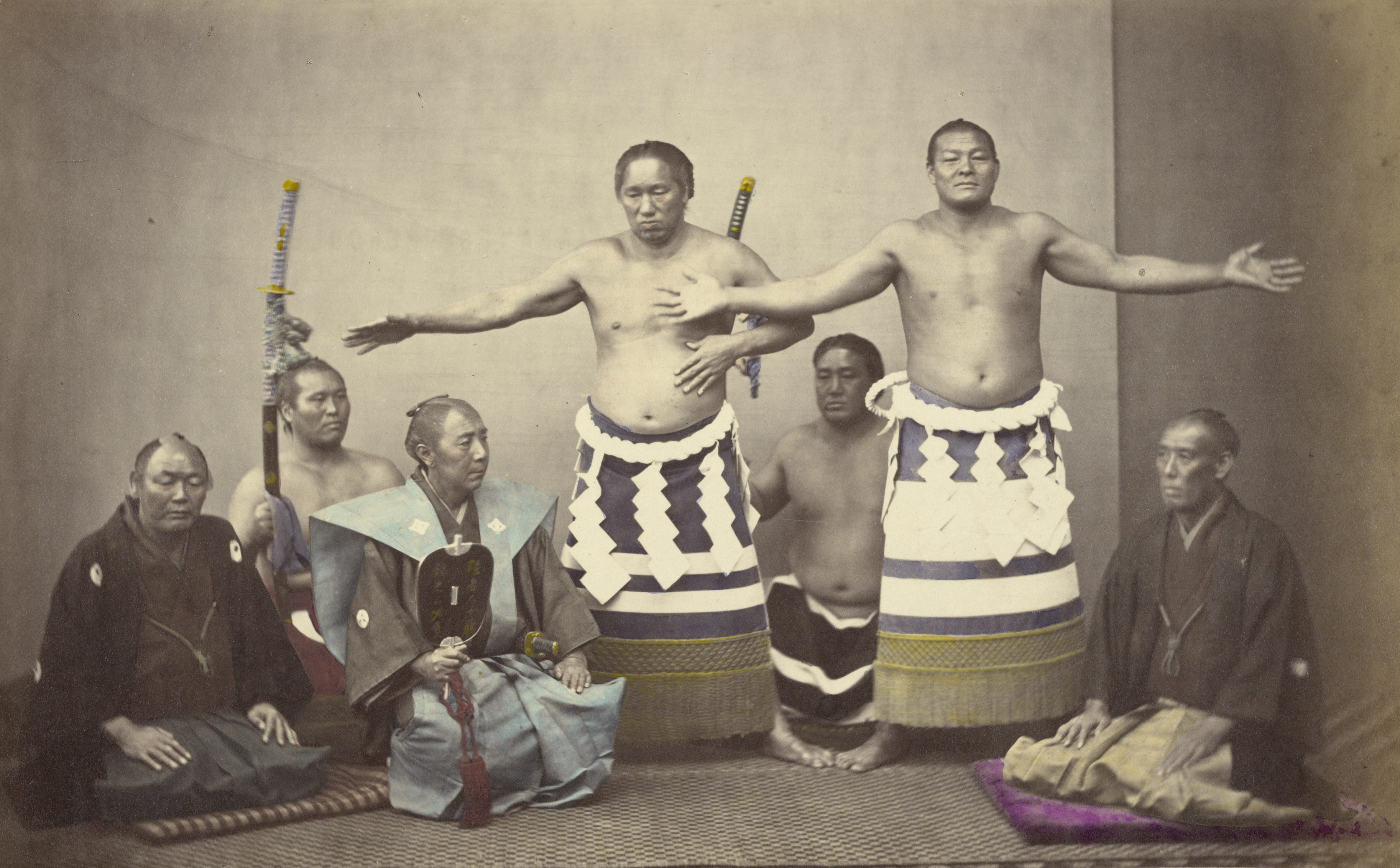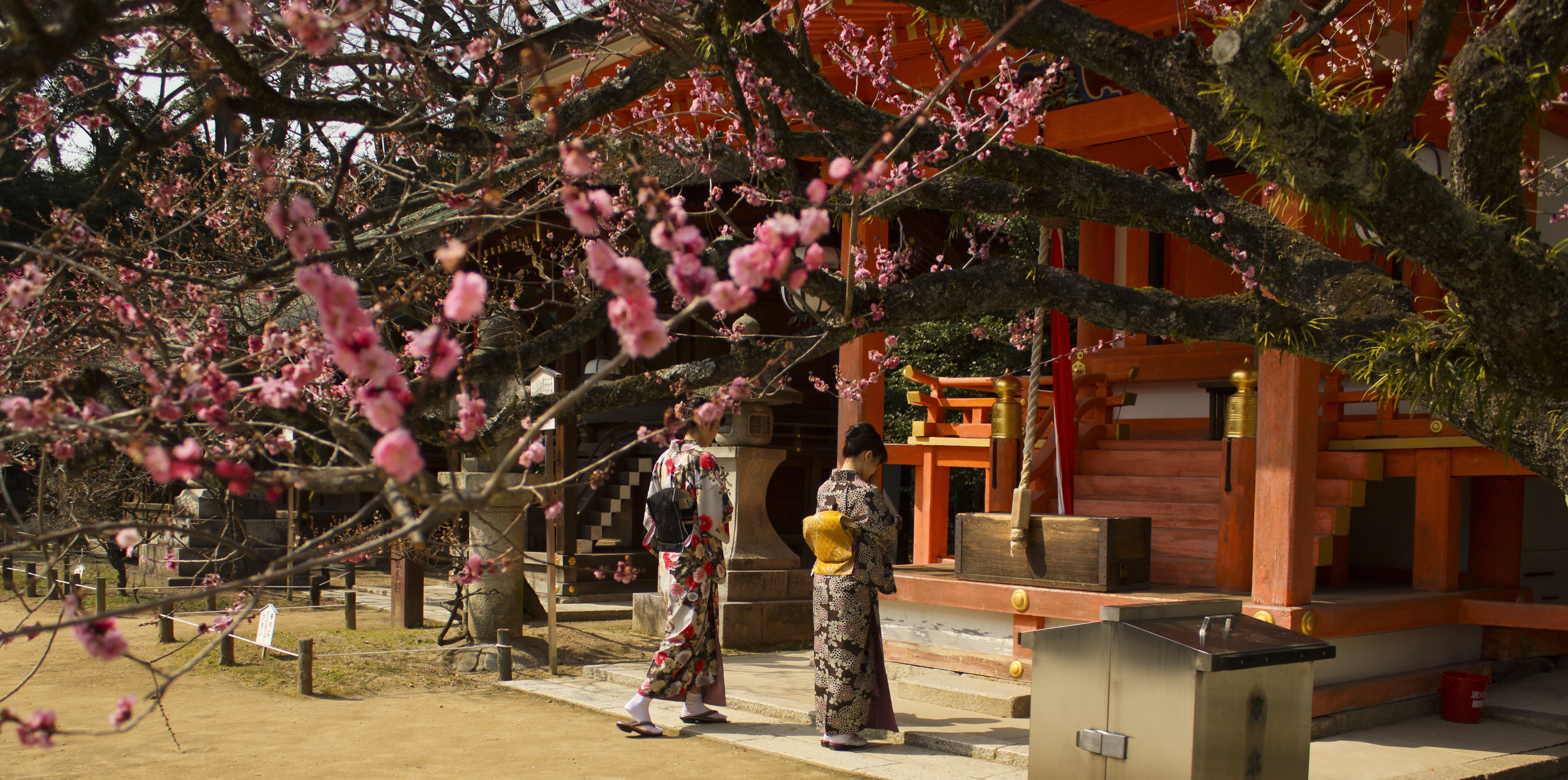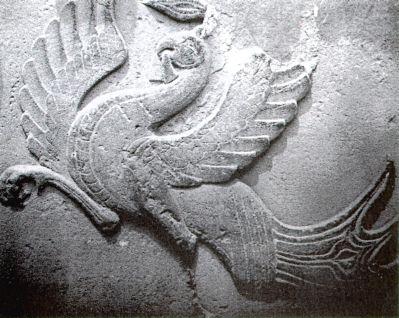|
Dohyō
A ''dohyō'' (, ) is the space in which a sumo wrestling bout occurs. A typical ''dohyō'' is a circle made of partially buried rice- straw bales 4.55 meters in diameter. In official professional tournaments ('' honbasho''), it is mounted on a square platform of clay 66 cm high and 6.7m wide on each side. Configuration and construction In professional sumo, a new ''dohyō'' is built prior to each tournament by the '' yobidashi'' (ring attendants), who are responsible for this activity. The process of building the ''dohyō'' and its 66 cm high platform takes three days and is done with traditional tools. The clay used is taken from the banks of the Arakawa River in Saitama Prefecture. However, due to growing urbanization, clay from Ibaraki Prefecture has started to be used. The surface is covered by sand. The ''dohyō'' is removed after each tournament and, in the case of the Nagoya tournament, pieces are taken home by the fans as souvenirs. The ''yobidashi'' also build ... [...More Info...] [...Related Items...] OR: [Wikipedia] [Google] [Baidu] |
Sumo
is a form of competitive full-contact wrestling where a ''rikishi'' (wrestler) attempts to force his opponent out of a circular ring (''dohyō'') or into touching the ground with any body part other than the soles of his feet (usually by throwing, shoving or pushing him down). Sumo originated in Japan, the only country where it is practised professionally and where it is considered the national sport. It is considered a ''gendai budō'', which refers to modern Japanese martial arts, but the sport has a history spanning many centuries. Many ancient traditions have been preserved in sumo, and even today the sport includes many ritual elements, such as the use of salt purification, from Shinto. Life as a wrestler is highly regimented, with rules regulated by the Japan Sumo Association. Most sumo wrestlers are required to live in communal sumo training stables, known in Japanese as ''Heya (sumo), heya'', where all aspects of their daily livesfrom meals to their manner of dressa ... [...More Info...] [...Related Items...] OR: [Wikipedia] [Google] [Baidu] |
Yobidashi
A , often translated in English as "usher", "ring attendant", or "ring announcer", is an employee of the Japan Sumo Association, responsible for various tasks essential to the traditional running of Sumo#Professional sumo, professional sumo tournaments () in Japan. The are involved in building the (wrestling ring) or calling wrestlers () to the ring when it is their turn to fight. They are also entrusted with other roles, both administrative and artistic, in the service of the heya (sumo), stable to which they are attached. Established during the Heian period, the role of was not codified until the Tenmei, Tenmei era. Nicknamed "sumo's workhorses" by former Takamiyama Daigorō, Takamiyama, the are required to wear traditional clothing in public and are subject to a strict hierarchy in their organisation. History The status of did not appear until 1750. Before the appearance of this term to specifically designate the staff responsible for announcing the wrestlers, several d ... [...More Info...] [...Related Items...] OR: [Wikipedia] [Google] [Baidu] |
Ryōgoku Kokugikan
, also known as Ryōgoku Sumo Hall or Kokugikan Arena, is the name bestowed to two different indoor sporting arenas located in Tokyo. The first ''Ryōgoku Kokugikan'' opened its doors in 1909 and was located on the premises of the Ekōin temple in Ryōgoku, Tokyo. Although no sumo bouts were held after 1945, following the capitulation of Japan and the requisition of the building by the occupying forces, the building itself remained active until 1983, being notably used by the Nihon University. The second ''Ryōgoku Kokugikan'' is currently located in the Yokoami neighborhood of Sumida next to the Edo-Tokyo Museum. It opened in 1985, following the closure of the Kuramae Kokugikan, and is still in use today. The first Ryōgoku Kokugikan History The growing popularity of Sumo during the Meiji period led to the building of the original Kokugikan in Ryōgoku. Until then, Sumo bouts were performed in temples precincts and depended on the weather. In March 1906, the 22nd Imperial ... [...More Info...] [...Related Items...] OR: [Wikipedia] [Google] [Baidu] |
House Of Yoshida Tsukasa
The , also commonly called Yoshida family, is a Japanese aristocratic family who was once responsible for the organization of professional sumo in History of Japan#Feudal Japan, feudal Japan, controlling ''rikishi'' (professional wrestlers) and ''gyōji'' (sumo referees) throughout the country, making sure that sumo etiquette was strictly observed, and granting the rank of ''yokozuna'' and ''Gyōji#System of promotion, tate-gyōji'' through a license system. Although still in existence today, the Yoshida family saw its authority over the sumo world diminish significantly during the Meiji restoration, and was only figurative by the early 1950s, until it ceased to be a nominating body when the Yokozuna Deliberation Council was created. History Origin At the beginning of the reign of shogun Tokugawa Ienari, the Edo-sumo organization toshiyori, elders undertook to make sumo charity events more respectable. In 1789, in response to edicts requiring official documents for the practice ... [...More Info...] [...Related Items...] OR: [Wikipedia] [Google] [Baidu] |
Japan Sumo Association
The , officially the ; sometimes abbreviated JSA or NSK, and more usually called Sumo Kyōkai, is the governing body that operates and controls Professional sports, professional sumo wrestling, called , in Japan under the jurisdiction of the Ministry of Education, Culture, Sports, Science and Technology, Japanese Ministry of Education, Culture, Sports, Science and Technology (MEXT). Concretely, the association maintains and develops sumo traditions and integrity by holding honbasho, tournaments and . The purposes of the association are also to develop the means dedicated to the sport and maintain, manage and operate the facilities necessary for these activities. Therefore, the JSA operates subsidiaries such as the Kokugikan Service Company to organize its economic aspects, the Sumo School to organize training and instruction or the Sumo Museum to preserve and utilize sumo wrestling records and artefacts. Though professionals, such as rikishi, active wrestlers, gyōji, referees, ... [...More Info...] [...Related Items...] OR: [Wikipedia] [Google] [Baidu] |
Honbasho
A , or Grand Sumo Tournament in English, is an official professional sumo tournament. Only ''honbasho'' results matter in determining promotion and relegation for '' rikishi'' (sumo wrestlers) on the '' banzuke'' ranking. The number of ''honbasho'' held every year and their length has varied; since 1958 there are six tournaments held over 15 consecutive days in four locations every year. Since 1926 the ''honbasho'' are organized by the Japan Sumo Association, after the merger of the Tokyo and Osaka sumo associations. Etymology The term ''honbasho'' means "main (or real) tournament" and is used to distinguish these tournaments from unofficial tournaments which are held as part of sumo tours, between the six major tournaments. Such display tournaments may have prize money attached but a wrestler's performance has no effect on his ranking. This type of sumo is often called ''hana-sumo'' ( flower-sumo) as it is not taken as seriously by the wrestlers. History In the Edo period, the ... [...More Info...] [...Related Items...] OR: [Wikipedia] [Google] [Baidu] |
Mon (emblem)
, also called , , and , are Japan, Japanese emblems used to decorate and identify an individual, a family, or (more recently) an institution, municipality or business entity. While is an encompassing term that may refer to any such device, and refer specifically to emblems that are used to identify a family. An authoritative reference compiles Japan's 241 general categories of based on structural resemblance (a single may belong to multiple categories), with 5,116 distinct individual . However, it is well acknowledged that there are a number of lost or obscure . Among , the officially used by the family is called . Over time, new have been created, such as , which is unofficially created by an individual, and , which is created by a woman after marriage by modifying part of her original family's , so that by 2023 there will be a total of 20,000 to 25,000 . The devices are similar to the Heraldic badge, badges and Coat of arms, coats of arms in European Heraldry, heraldic ... [...More Info...] [...Related Items...] OR: [Wikipedia] [Google] [Baidu] |
Stone Bridge Press
Stone Bridge Press, Inc. is a publishing company distributed by Consortium Book Sales & Distribution and founded in 1989. Authors published include Donald Richie and Frederik L. Schodt. Stone Bridge publishes books related to Japan, having published some 90 books on a wide variety of subjects: anime and manga, calligraphy, and origami; guides on Japanese customs, culture, and aesthetics; Japanese language books, Japan-related fiction, poetry, and nonfiction. Recently, Stone Bridge has broadened its subjects to more of Asia, and have published books on Korea and China, as well. History Stone Bridge Press was founded in 1989 by Peter Goodman. Seventeen years later in 2005, Goodman sold the press to Japanese book distributor Yohan Inc. Shortly before Yohan Inc. announced their bankruptcy in July 2008, Stone Bridge was bought by IBC (Intercultural Book Company) Publishing of Tokyo, a former Yohan subsidiary. In Fall 2009, Goodman reacquired Stone Bridge from IBC. [...More Info...] [...Related Items...] OR: [Wikipedia] [Google] [Baidu] |
Shinto Shrine
A Stuart D. B. Picken, 1994. p. xxiii is a structure whose main purpose is to house ("enshrine") one or more kami, , the deities of the Shinto religion. The Also called the . is where a shrine's patron is or are enshrined.Iwanami Japanese dictionary The may be absent in cases where a shrine stands on or near a sacred mountain, tree, or other object which can be worshipped directly or in cases where a shrine possesses either an altar-like structure, called a himorogi, , or an object believed to be capable of attracting spirits, called a yorishiro, , which can also serve as direct bonds to a . There may be a and other structures as well. Although only one word ("shrine") is used in English, in Japanese, Shinto shrines may carry any one of many different, non-equivalent names like , , , , , , , , , or . Miniature shrines (hokora, ) can occasionally be found on roadsides. Large shrines sometimes have on their precincts miniature shrines, or . Because the and once had differe ... [...More Info...] [...Related Items...] OR: [Wikipedia] [Google] [Baidu] |
Shinmei-zukuri
is an ancient Japanese architectural style typical of Ise Grand Shrine's ''honden'', the holiest of Shinto shrines.Encyclopedia of Shinto It is most common in Mie Prefecture.JAANUS History Ancient shrines were constructed according to the style of dwellings ( Izumo Taisha)Young & Young (2007:50)Kishida (2008:33) or storehouses (Ise Grand Shrine).Fletcher and Cruickshank (1996:724) The buildings had gabled roofs, raised floors, plank walls, and were thatched with reed or covered with hinoki cypress bark. Such early shrines did not include a space for worship. Three important forms of ancient shrine architectural styles exist: '' taisha-zukuri'', ''shinmei-zukuri'', and '' sumiyoshi-zukuri''Kishida (2008:34) They are exemplified by Izumo Taisha, Nishina Shinmei Shrine and Sumiyoshi Taisha,Kishida (2008:35) respectively, and date to before 552.Kishida (2008:126) According to the tradition of '', the buildings or shrines were faithfully rebuilt at regular intervals adhering to ... [...More Info...] [...Related Items...] OR: [Wikipedia] [Google] [Baidu] |
Vermilion Bird Of The South
The Vermilion Bird ( zh, c=朱雀, p=Zhūquè) is one of the Four Symbols of the Chinese constellations. According to Wu Xing, the Taoist five elemental system, it represents the Fire element, the direction south, and the season of summer correspondingly. Thus it is sometimes called the Vermilion Bird of the South ( zh, c=南方朱雀, p=Nán Fāng Zhū Què). It is described as a red bird that resembles a pheasant with a fire-colored plumage and is perpetually covered in flames. It is known as Suzaku in Japanese, Jujak in Korean and Chu Tước in Vietnamese. It is often mistaken for the Fenghuang due to similarities in appearance, but the two are different creatures. The Fenghuang is a legendary ruler of birds who is associated with the Chinese Empress in the same way the dragon is associated with the Emperor, while the Vermilion Bird is a mythological spirit creature of the Chinese constellations. Seven Mansions of the Vermilion Bird As with the other three Symbols, there ... [...More Info...] [...Related Items...] OR: [Wikipedia] [Google] [Baidu] |
Four Symbols (Chinese Constellation)
The Four Symbols are mythological creatures appearing among the Chinese constellations along the ecliptic, and viewed as the guardians of the four cardinal directions. These four creatures are also referred to by a variety of other names, including "Four Guardians", "Four Gods", and "Four Auspicious Beasts". They are the Azure Dragon of the East, the Vermilion Bird of the South, the White Tiger of the West, and the Black Tortoise (also called "Black Warrior") of the North. Each of the creatures is most closely associated with a cardinal direction and a color, but also additionally represents other aspects, including a season of the year, an emotion, virtue, and one of the Chinese " five elements" (wood, fire, earth, metal, and water). Each has been given its own individual traits, origin story and a reason for being. Symbolically, and as part of spiritual and religious belief and meaning, these creatures have been culturally important across countries in the Sinosphere. Hist ... [...More Info...] [...Related Items...] OR: [Wikipedia] [Google] [Baidu] |








